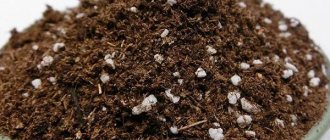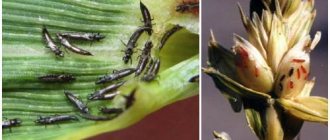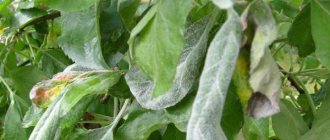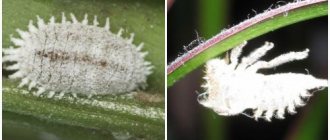Powdery mildew is an infectious disease caused by fungi. Its traces can be seen not only on flowers, but also on grain crops, fruit trees and berry bushes.
The spores of this pathogen are characterized by long-term viability. They can “sleep” in the soil for several decades.
Activation occurs when favorable conditions for reproduction occur.
There are several types of fungi. Powdery mildew on roses is caused by Sphaeroteca pannosa. Its activators are heat, high air humidity, and excessive amounts of nitrogen compounds in the soil. Rose bushes, which are dense, are most often infected. Therefore, a musty smell hovering near the plant can be considered an indirect sign of the disease.
How to identify powdery mildew and why it is dangerous
First of all, the stalks, petioles and young shoots located below the rest are infected. A white coating forms on them, in which mycelium can be recognized. After the spores mature, water droplets appear on it. In the absence of timely treatment, the ulcers spread to the entire plant.
As a result, its appearance becomes unattractive, and the aroma emanating from roses changes for the worse. This can be explained by a lack of nutrients.
Leaves affected by powdery mildew suffer from necrosis and turn yellow due to lack of photosynthesis. Flowers stop blooming, buds become very small.
The plant at the last stage of this disease is a bare stem, on the surface of which only a felt coating can be seen. Due to its structure and characteristics of the latter, the rose does not develop. The resulting cracks become a haven for rot pathogens. It is unlikely that such a bush will be able to survive the winter.
The disease has several names. In addition to the generally accepted ones, there are such popular designations as “bel”, “ashpelitsa” and “muchka”. Obvious symptoms greatly facilitate diagnosis.
Pathogens can be transferred from a diseased plant to a healthy one with the help of insects, wind or pests.
Peak fungal activity begins in June.
Treatment of roses to protect against cytosporosis disease
Cytosporosis is a fungal disease of roses in the photo
Cytosporosis is a fungal disease that is widespread throughout the world. Roses affect a number of ornamental shrubs, as well as pome and stone fruit trees and nuts.
Cytosporosis is also called infectious drying out. In some years, it leads not only to the drying out of individual branches, but also to the death of plants. Bushes that are weakened as a result of freezing, drought, sunburn, untimely pruning, etc. are especially susceptible to this disease.
First, the causative agent of the disease settles on dying individual areas of the bark. Large, clearly visible orange-red fungal pycnidia tubercles appear over the entire area of the affected bark, protruding from under the skin.
Try varieties of hybrid tea roses from a trusted supplier:











